| Project
Summary: Tibetan Ressetlement Project
OWNER/DEVELOPER
Tibetan Government in Exile
ARCHITECT
MTFA Architecture, Inc.
LANDSCAPE
ARCHITECT
Adit Pal & Associates
CONTRACTORS
Aleem & Associates PROPERTY
MANAGEMENT
Tibetan Government in Exile
| FUNDERS: |
TYPE: |
| All fuding was private. |
|
DEVELOPMENT
TYPE:
New construction permanent housing.
RESIDENT
PROFILE:
Tibetan refugees living in India.
DENSITY:12 units per acre
DEVELOPMENT
PROFILE
| Type |
#/Units |
Size
(sf) |
Rent |
| Apt with sleeping loft |
160 |
200sf |
Pay in community service activities. |
| Total |
160 |
|
|
| Total site area:
14 acres |
CONSTRUCTION
TYPE
Masonry with steel roofs.
DEVELOPMENT
COSTS:
Land cost: $110,000; Constr. costs:
$; Other costs: $; Total
development costs: $7,400,000 ($46,250/unit);
Completed in March 2005. |
|
|
Tibet Resettlement Project - Dehradun, India
Green Features
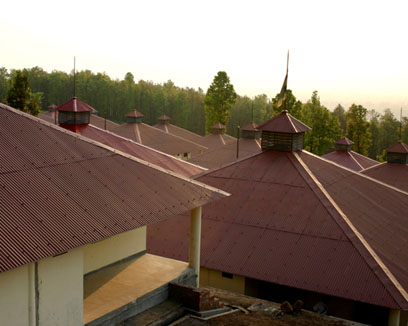
Millions of Tibetans have fled their native homeland because of religious persecution. This resettlement community is designed to provide dignified, culturally based housing for 800 to 1000 Tibetans currently homeless or living in desperate conditions as refugees in India. Those who are most in need are given priority. In addition to housing, the community’s Master Plan includes a Gompa (a Tibetan house of worship), a dispensary, a crafts and education building and plans for a future school.
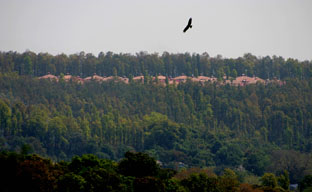 Located in the foothills of the Himalayas, just outside the city of Dehradun, India, the site is along a mountain ridge bound by a reserve forest and an agribusiness parcel. Flanked by natural settings on all sides, the village is a beacon on the hill for the entire Dehradun Valley. The location is important as it carefully balances the Tibetan need for seclusion with the practical need for access to bus transportation in the community. The design, while permanent, echoes that of a tent city, symbolic of the hope that all Tibetans will one day return to their homeland. Since this housing project is meant to distinguish the Tibetan plight, it reflects the vibrant colors and order of their culture. The rich hue of the walls was achieved by mixing natural dyes into the masonry parging. This ensures that the color will last without the need for painting or the introduction of VOCs.
Located in the foothills of the Himalayas, just outside the city of Dehradun, India, the site is along a mountain ridge bound by a reserve forest and an agribusiness parcel. Flanked by natural settings on all sides, the village is a beacon on the hill for the entire Dehradun Valley. The location is important as it carefully balances the Tibetan need for seclusion with the practical need for access to bus transportation in the community. The design, while permanent, echoes that of a tent city, symbolic of the hope that all Tibetans will one day return to their homeland. Since this housing project is meant to distinguish the Tibetan plight, it reflects the vibrant colors and order of their culture. The rich hue of the walls was achieved by mixing natural dyes into the masonry parging. This ensures that the color will last without the need for painting or the introduction of VOCs.
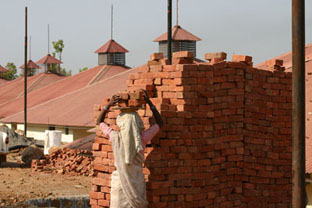
 This project is integrally sustainable. The materials consist primarily of brick made on site with excavated clay, stucco plaster and insulated steel beam roofs. The refugees were trained to help build the dwellings. This provided the residents durable homes built with pride along with the dignity of having established economic sustainability through trade education. Economic sustainability is also supported by agriculture. The residents of each dwelling are responsible for a 10x10 vegetable plot. The crops from these plots feed the community and excess produce is sold. This project is integrally sustainable. The materials consist primarily of brick made on site with excavated clay, stucco plaster and insulated steel beam roofs. The refugees were trained to help build the dwellings. This provided the residents durable homes built with pride along with the dignity of having established economic sustainability through trade education. Economic sustainability is also supported by agriculture. The residents of each dwelling are responsible for a 10x10 vegetable plot. The crops from these plots feed the community and excess produce is sold.
Just as the projectís sustainable concepts involve an integrated construction process and self-sustaining agriculture, the design process was an iterative workshop with the Tibetan Elders. The village of houses, while simple, reflects subtle shifts in the planning grid to open vistas for sun, prevailing breezes and views. The sloped site allows for an appropriately dense concentration of dwellings and the terraced landscape responds to the siteís microclimate and assists in water distribution. Perimeter roof drains at the base of each unit collect and reuse water while preventing erosion during monsoons. All the homes are equipped with enclosed sanitary sewer drains for a healthy environment.
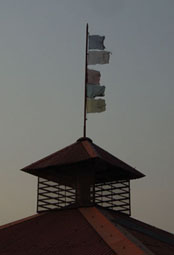 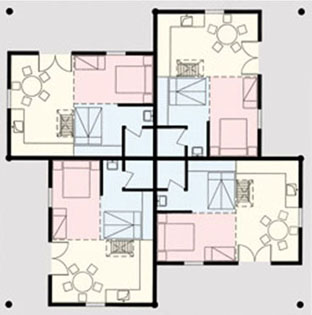 The individual units are designed to house 5 to 6 people. Each unit is oriented with its own private front door per façade. Inside there is a kitchen area, dining area and day room. The day room is used for sleeping at night and there is a sleeping loft above, within the pyramid shaped volume of the roof. In addition to added sleeping space, the roof volume sheds the monsoon rain and draws the hot summer air upwards to be naturally ventilated through a cupola. The masonry walls and natural ventilation keep the interior cool during the heat of the mid day sun, and reversely this stored heat radiates outward during the cool mountain evenings. Coal stoves provided for cooking also adequately warms the units on cooler days. Basic electricity is provided for simple lighting and outlets for personal use. The pinwheel floor plan evokes the sacred symbol of the Tibetan Mandala. The village’s prayer flag is centrally mounted to allow the prayers and aspirations of the Tibetans to flow up and out across the world. The individual units are designed to house 5 to 6 people. Each unit is oriented with its own private front door per façade. Inside there is a kitchen area, dining area and day room. The day room is used for sleeping at night and there is a sleeping loft above, within the pyramid shaped volume of the roof. In addition to added sleeping space, the roof volume sheds the monsoon rain and draws the hot summer air upwards to be naturally ventilated through a cupola. The masonry walls and natural ventilation keep the interior cool during the heat of the mid day sun, and reversely this stored heat radiates outward during the cool mountain evenings. Coal stoves provided for cooking also adequately warms the units on cooler days. Basic electricity is provided for simple lighting and outlets for personal use. The pinwheel floor plan evokes the sacred symbol of the Tibetan Mandala. The village’s prayer flag is centrally mounted to allow the prayers and aspirations of the Tibetans to flow up and out across the world.
Lessons Learned from the architect - It’s important to be sensitive to the local climate, culture and indigenous feel of the area in which you are working. This offers the opportunity to capture the local efficiencies of a place, rather than using materials, methods and styles from another region and bending over backwards to make them work. A certain authenticity and beauty comes from designing locally that is inherently more sustainable than homogenous architecture that is distinctly placeless and oddly out of character.
Green Features
Click here to see the AIA Affordable Green Guidelines
|
Tibetan Resettlement Project
|
| Access to Public Transportation |
The site is within walking distance to local bus service.
|
| Compact Development |
The project density is 12 units per acre.
|
| Passive Heating and/or Cooling |
The roof volume draws the hot summer air upwards to be naturally ventilated through a cupola. The masonry walls and natural ventilation keep the interior cool during the heat of the mid day sun, and reversely this stored heat radiates outward during the cool mountain evenings. |
| Daylighting |
Each unit has light shelves and a cupola for daylight distribution. |
| High Performance WIndows |
In Dehradun, India's climate, heat gain avoidance is more important than insulation. As such the windows are recycled steel frame with single pane low-e heat mirror glass. |
| Stormwater Management |
The terraced site avoids erosion during the monsoon season and distributes rainfall for increased infiltration into the soil. |
| Water Efficient Landscaping |
All plantings are indigenous. |
| Water Saving Appliances |
The Indian style toilets are low flush. |
| Local Materials |
The brick is made from excavated clay on site. |
| Low VOC Materials |
The use of natural dyes to pigment the wall parging has no VOC's. |
| Other Innovations |
The residents were trained in construction trades during the building process and each resident cultivates crops to feed the village and excess is sold to generate income for the community.
|
|
 This project is integrally sustainable. The materials consist primarily of brick made on site with excavated clay, stucco plaster and insulated steel beam roofs. The refugees were trained to help build the dwellings. This provided the residents durable homes built with pride along with the dignity of having established economic sustainability through trade education. Economic sustainability is also supported by agriculture. The residents of each dwelling are responsible for a 10x10 vegetable plot. The crops from these plots feed the community and excess produce is sold.
This project is integrally sustainable. The materials consist primarily of brick made on site with excavated clay, stucco plaster and insulated steel beam roofs. The refugees were trained to help build the dwellings. This provided the residents durable homes built with pride along with the dignity of having established economic sustainability through trade education. Economic sustainability is also supported by agriculture. The residents of each dwelling are responsible for a 10x10 vegetable plot. The crops from these plots feed the community and excess produce is sold.




 The individual units are designed to house 5 to 6 people. Each unit is oriented with its own private front door per façade. Inside there is a kitchen area, dining area and day room. The day room is used for sleeping at night and there is a sleeping loft above, within the pyramid shaped volume of the roof. In addition to added sleeping space, the roof volume sheds the monsoon rain and draws the hot summer air upwards to be naturally ventilated through a cupola. The masonry walls and natural ventilation keep the interior cool during the heat of the mid day sun, and reversely this stored heat radiates outward during the cool mountain evenings. Coal stoves provided for cooking also adequately warms the units on cooler days. Basic electricity is provided for simple lighting and outlets for personal use. The pinwheel floor plan evokes the sacred symbol of the Tibetan Mandala. The village’s prayer flag is centrally mounted to allow the prayers and aspirations of the Tibetans to flow up and out across the world.
The individual units are designed to house 5 to 6 people. Each unit is oriented with its own private front door per façade. Inside there is a kitchen area, dining area and day room. The day room is used for sleeping at night and there is a sleeping loft above, within the pyramid shaped volume of the roof. In addition to added sleeping space, the roof volume sheds the monsoon rain and draws the hot summer air upwards to be naturally ventilated through a cupola. The masonry walls and natural ventilation keep the interior cool during the heat of the mid day sun, and reversely this stored heat radiates outward during the cool mountain evenings. Coal stoves provided for cooking also adequately warms the units on cooler days. Basic electricity is provided for simple lighting and outlets for personal use. The pinwheel floor plan evokes the sacred symbol of the Tibetan Mandala. The village’s prayer flag is centrally mounted to allow the prayers and aspirations of the Tibetans to flow up and out across the world.